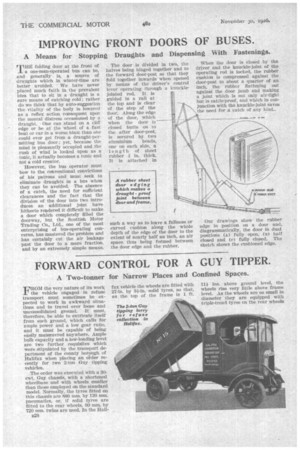IMPROVING FRONT DOORS OF BUSES.
Page 54

If you've noticed an error in this article please click here to report it so we can fix it.
A Means for Stopping
Draughts and
Dispensing With Fastenings.
rill:1E folding door at the front of 1_ a one-man-operated bus can be, and generally is, a source of draughts which in winter-time are better avoided. " We have never placed much faith in the prevalent idea that to sit in a draught is a sure means of catching cold ; rather do we think that by auto-suggestion the vitality of the body is lowered as a reflex action consequent upon the mental distress occasioned by a draught. One can stand on a cliff edge or be at the wheel of a fast boat or car in a worse blast than one could ever get from a draught-permitting bus door ; yet, because the mind is pleasantly occupied and the rush of wind is looked upon as a tonic, it actually becomes a tonic and not a cold creator.
However, the bus operator must bow to the conventional convictions of his patrons and must seek to eliminate draughts in a bus when they can be avoided. The absence of a catch, the need for sufficient clearances and the fact that the division of the door into two introduces an additional joint have hitherto rendered it difficult to make a door which completely filled the doorway, but the Scottish Motor TradingCo., Ltd., one of the most enterprising of bus-operating concerns, has Plastered the problem and has certainly cut the air leakage past the door to a mere fraction, and by an extremely simple means. The door is divided in two, the halves being hinged together and to the forward door-post so that they fold together Inwards when opened by means of the driver's control lever operating through a knucklejointed rod. It is guided in a rail at the top and is clear of the step of the floor. Along the edge of the door, which when the door is closed butts on to the after door-post, is secured by two aluminium beads, one on each side, a length of sheet rubber 11 in. thick. It is attached in such a way as to leave a fullness or curved cushion along the whole depth of the edge of the door to the extent of nearly half an inch, an air space thus being formed between the door edge and the rubber. When the door is closed by the driver and the knuckle-joint of the operating rod is locked, the rubber cushion is compressed against the door-post to about a quarter of an inch, . the rubber flattening out against the door jamb and making a joint which is not only air-tight but is rattle-proof, and which in conjunction with the knuckle-joint saves the need for a catch of any kind..
Our drawings show the rubber edge in position on a door and, diagrammatically, the door in dual positions (A) fully open, (n) half closed and (c) fully closed. The sketch shows the cushioned edge.




















































































































